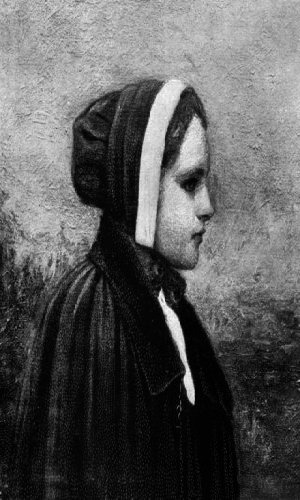Bridget Bishop, "a singular character, not easily described," was born sometime between 1632 and 1637. Bishop married three times. Her third and final marriage, after the deaths of her first two husbands, was to Edward Bishop, who was employed as a "sawyer" (lumber worker). She appears to have had no children in any of her marriages.
Although Bishop had been accused by more individuals of witchcraft than any other witchcraft defendant (many of the accusations were markedly vehement and vicious), it was not so much her "sundry acts of witchcraft" that caused her to be the first witch hanged in Salem, as it was her flamboyant life style and exotic manner of dress. Despite being a member of Mr. Hale's Church in Beverly (she remained a member in good standing until her death), Bishop often kept the gossip mill busy with stories of her publicly fighting with her various husbands, entertaining guests in home until late in the night, drinking and playing the forbidden game of shovel board, and being the mistress of two thriving taverns in town. Some even went so far as to say that Bishop's "dubious moral character" and shameful conduct caused, "discord [to] arise in other familes, and young people were in danger of corruption." Bishop's blatant disregard for the respected standards of puritan society made her a prime target for accusations of witchcraft.
In addition to her somewhat outrageous (by Puritan standards) lifestyle, the fact that Bishop "was in the habit of dressing more artistically than women of the village" also contributed in large part to her conviction and execution. She was described as wearing, "a black cap, and a black hat, and a red paragon bodice bordered and looped with different colors." This was a showy costume for the times. Aside from encouraging rumors and social disdain, this "showy costume" was used as evidence against her at her trial for witchcraft. In his deposition, Shattuck, the town dyer mentions, as corroborative proof of Bishop being a witch, that she used to bring to his dye house "sundry pieces of lace" of shapes and dimensions entirely outside his conceptions of what would be needed in the wardrobe of a plain and honest woman. Fashionable apparel was regarded by some as a "snare and sign of the devil."
On April 18, 1692, when a warrant was issued for Bishop's arrest for witchcraft, she was no stranger to the courthouse. In 1680 she had been charged (but cleared) of witchcraft, and on other occasions she had ended up in the courthouse for violent public quarreling with her husband. Bishop had never seen or met any of her accusers until her questioning. While several of the afflicted girls cried out and writhed in the supposed pain she was causing them, John Hathorn and Jonathan Corwin questioned her, although there was little doubt in either of their minds as to her guilt:
When asked by one of her jailers, Bishop claimed that she was not troubled to see the afflicted persons so tormented, and could not tell what to think of them and did not concern herself about them at all. But the afflicted girls were not Bishop's only accusers. Her sister's husband claimed that "she sat up all night conversing with the Devil" and that "the Devil came bodily into her." With a whole town against her, Bishop was charged, tried, and executed within eight days. On June 10, as crowds gathered to watch, she was taken to Gallows Hill and executed by the sheriff, George Corwin. She displayed no remorse and professed her innocence at her execution.
Bishop's death did not go unnoticed in Salem. The court took a short recess, accusations slowed down for a time, more than a month passed before there were any more executions, and one of the judges, Nathaniel Saltonstall resigned, having become dissatisfied with the court's methods. Even Governor Phips had doubts about the methods of the court and went to Boston to consult the ministers there as to what should be done with the rest of the accused. Unfortunately for the eighteen others who would be hanged as witches (in addition to the one pressed to death and the several who died in prison), the ministers decidedly and earnestly recommended that the proceedings should be "vigorously carried on," and so they were. Less than a year after her death, Bishop's husband married Elizabeth Cash, and several of those who had testified against her, in deathbed confessions claimed that their accusations were "deluted by the Devil." --KS

